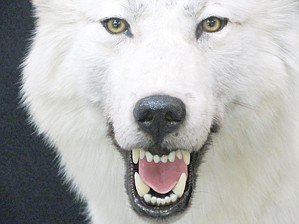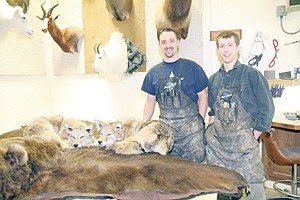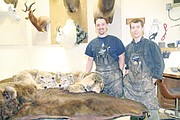Hayes: Wolves make for good business
When John Hayes started studying taxidermy he didn’t think it one day would be his livelihood.
After stints with logging, working at sawmills and time in the forests, Hayes came back to what he loves, recreating wildlife art.
In 2010, he bought Dumont Taxidermy, and hasn’t given a return to the forests another thought — at least not for logging. All total, he’s been doing taxidermy for 21 years.
Like most taxidermists, his desire of preserving nature stems from his love of wildlife and game he pursued during those hunts.
“They’re really beautiful animals,” said Hayes, 37, of wolves and coyotes. “There are those who say they affect deer and elk herds. We do know that’s true in Yellowstone.”
An admitted predator hunter — pursuing coyotes and wolves — Hayes said he has found his taxidermy niche in preserving these contentious canines.
“They are about 20 percent of my business now,” Hayes said. “Things are good. We look to expand our building by about 100 percent and add another taxidermist.”
With wolf hunting still in its infancy, Hayes has provided images of wolves for the trapping class held at Asa Wood, providing wolf rugs and pelts.
For the current wolf season, through the end of the general deer and elk season, hunters in Northwest Montana have taken 32 wolves, said John Fraley, the FWP publicist in Kalispell.
Statewide, 93 wolves have been taken. This is slightly ahead of last year at the end of the general deer and elk season. The wolf-hunting season continues until March 15.
Hunters can still purchase a wolf-hunting license, but there is a 24-hour waiting period before it is valid. Wolf trapping began Sunday, Dec. 15.
Wolf trappers must purchase a furbearer-trapping license, and have completed the wolf-trapping certification course to trap wolves. The bag limit is five wolves per hunter/trapper in any combination of hunting or trapping.
That number was increased this year.
In addition to his popular wolf rugs, Hayes started doing “predator pillows” as he called them. These are full-bodied, coyote and wolf cushioned mounts that depict the predator in a curled, almost petlike pose.
“They’ve been a big hit,” Hayes said.
Hayes employs Andrew Lovick, who specializes in fish, but his shop features a little bit of everything from a Kodiak bear rug to the rare fisher that was brought in Thursday afternoon.
The walls of his shop at 204 Bothman Drive are lined with mountain goats, African kudus, deer, mountain lions, bears, just about everything, including the canines.
“I love predator hunting,” Hayes said. “That’s what I used to do most, before I got so busy with the shop.”
His wolf mount clients include a New York art gallery, Jesse Jackson, Jr., the Smithsonian, and executives from Phillips Petroleum of Tulsa, Okla., as well as customers all over the globe.
Taxidermy clientele grows by word of mouth, Hayes said.
“I did one (mountain) goat mount for a Coast Guard guy in Alaska. He told his friends, and now I’m mounting all his buddies’ goats,” Hayes said.
Recently, Hayes assisted fellow taxidermist Mel Siefke, who garnered a big contract with a sporting goods company.
“I helped him out in a pinch, to meet a deadline,” Hayes said. “Right now, I’ve got a lot of my own to do. We’ve got some great taxidermists in the area with the likes of Mel, Gerry Mercer and Scott Lennard. All of these guys make us better.”



